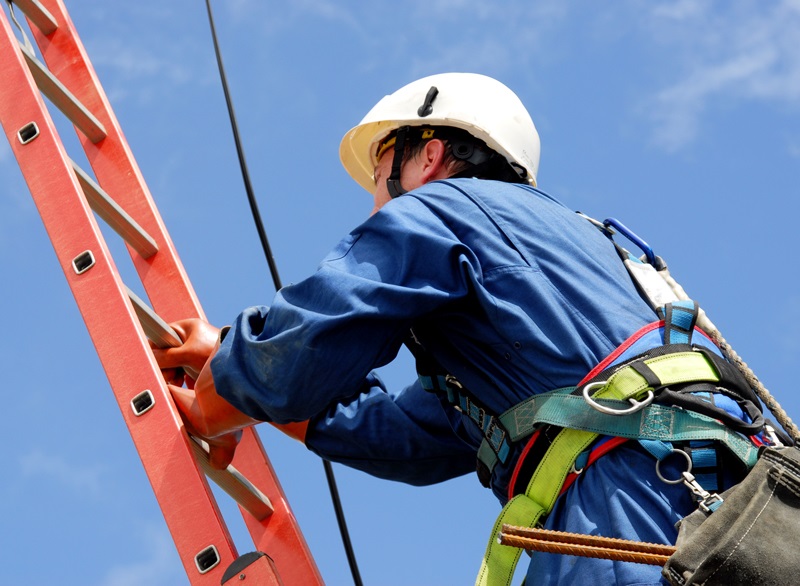Working at heights presents significant risks, making it essential to prioritize safety measures to protect your crew.
Whether on construction sites, maintenance tasks, or tree trimming, the potential for falls and accidents increases dramatically with elevation. This article outlines crucial safety tips for working at heights, emphasizing the importance of training, equipment, and procedures.
Understanding the Risks of Working at Heights
Falls from heights remain one of the leading causes of workplace injuries and fatalities. According to the Occupational Safety and Health Administration (OSHA), falls account for approximately 34% of construction-related deaths. The risks can stem from various factors, including:
- Inadequate Training: Workers may lack the knowledge of safe practices and equipment use.
- Improper Equipment Use: Failure to use the right tools or safety gear can lead to accidents.
- Unstable Work Surfaces: Slippery or uneven surfaces can increase the likelihood of falls.
- Environmental Hazards: Weather conditions, such as wind and rain, can also contribute to unsafe working conditions.
Essential Safety Tips for Working at Heights
1. Provide Comprehensive Training
Before beginning any work at heights, it is crucial to train your crew on safety protocols and equipment use. Training should cover:
- Risk Awareness: Educate workers about the dangers associated with working at heights.
- Use of Personal Protective Equipment (PPE): Ensure that everyone knows how to properly wear and maintain their safety gear, including harnesses, helmets, and non-slip footwear.
- Safe Ladder and Scaffolding Use: Teach proper ladder placement, weight limits, and how to assemble and use scaffolding safely.
2. Conduct Thorough Risk Assessments
Before starting any project involving work at heights, perform a comprehensive risk assessment. This assessment should include:
- Site Inspection: Evaluate the work area for potential hazards, such as unstable surfaces or overhead obstructions.
- Task Analysis: Identify the specific tasks that will be performed at heights and assess the associated risks.
- Control Measures: Develop strategies to mitigate identified risks, including the use of safety equipment and barriers.
3. Use the Right Equipment
Choosing the appropriate equipment is critical for ensuring safety when working at heights. Some key equipment considerations include:
- Personal Fall Arrest Systems (PFAS): Utilize harnesses, lanyards, and anchor points designed to prevent falls. Ensure that all equipment is regularly inspected and maintained.
- Ladders: Use only ladders rated for the required load and height. Ensure they are placed on stable ground and at the correct angle (approximately 75 degrees).
- Scaffolding: When using scaffolding, ensure it is properly erected and inspected before use. Install guardrails and toe boards to prevent falls.
4. Implement Safe Work Practices
Developing and enforcing safe work practices is essential for minimizing risks. Consider the following guidelines:
- Establish Clear Protocols: Create standard operating procedures (SOPs) for working at heights, including emergency procedures in case of a fall.
- Use a Buddy System: Encourage workers to operate in pairs when working at heights to ensure immediate assistance in case of an emergency.
- Maintain Communication: Use radios or hand signals to maintain communication between workers at heights and those on the ground, especially in noisy environments.
5. Monitor Weather Conditions
Weather can significantly impact the safety of working at heights. Monitor weather conditions closely and take the following precautions:
- Postpone Work in Adverse Weather: If conditions are too windy, rainy, or icy, delay work until conditions improve.
- Adapt to Changing Conditions: Be aware of sudden weather changes and have a plan in place to evacuate workers safely.
6. Ensure Proper Supervision
Supervision is crucial for maintaining safety on sites where work is conducted at heights. Ensure that:
- A Competent Person is Present: Designate a competent individual responsible for overseeing safety practices and ensuring compliance with safety regulations.
- Regular Safety Audits: Conduct routine audits to identify potential hazards and ensure compliance with safety protocols.
7. Promote a Safety Culture
Fostering a culture of safety within your organization can significantly enhance awareness and compliance with safety measures. Consider the following strategies:
- Encourage Reporting of Hazards: Create an open environment where workers feel comfortable reporting potential hazards or unsafe practices without fear of repercussions.
- Provide Regular Safety Meetings: Schedule frequent safety meetings to reinforce the importance of safety and discuss any recent incidents or near-misses.
Conclusion
Working at heights is inherently dangerous, but with proper safety measures, training, and equipment, the risks can be significantly reduced.
By prioritizing safety and fostering a culture of awareness, you can protect your crew and ensure a safer working environment.
Remember, safety is not just a set of rules; it’s a commitment to your team’s well-being. Always review and update safety protocols, and stay informed about the latest industry standards to maintain a safe working environment.
Also Read
Insulation tips: How to choose the right materials for your project
Top tips for selecting durable flooring materials: A comprehensive guide

